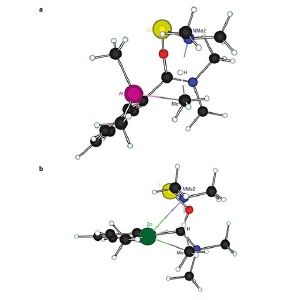Apr 10 2009
An aluminum-based chemical reagent designed by a RIKEN scientist could prove to be a useful way of building complex carbon compounds, such as novel pharmaceuticals.
 Schematic of the structures of the aluminate (a) and zincate (b) reagents. The aluminum atom (purple) is less able to attract electrons from the nitrogen atom (blue) in this intermediate molecule. This leads to a different end product than the zinc-based reagent.
Schematic of the structures of the aluminate (a) and zincate (b) reagents. The aluminum atom (purple) is less able to attract electrons from the nitrogen atom (blue) in this intermediate molecule. This leads to a different end product than the zinc-based reagent.
The aluminate reagent (i-Bu3Al(TMP)Li) is able to pluck a hydrogen atom away from a carbon atom to create a new carbon–aluminum bond. The aluminum can then be replaced by a wide variety of other chemical groups, allowing new compounds to be constructed.
Masanobu Uchiyama of RIKEN’s Advanced Science Institute in Wako, and colleagues at Tohuku University, Japan, and the University of Cambridge, UK, have now uncovered exactly how the aluminate reagent works, and for which reactions it is most suitable*.
Uchiyama and colleagues used density functional theory to calculate how chemical reactions involving the aluminum reagent were likely to proceed. This technique relies on quantum theory to determine how electrons are spread around the molecules involved in a reaction.
This revealed that it is specifically the ring-shaped TMP portion of the aluminate reagent that is responsible for removing a hydrogen atom at the beginning of the reaction; a conclusion confirmed by subsequent experiments.
The aluminate also requires only a single chemical step to remove the hydrogen atom from its target. But this process is markedly different when using an analogous zinc-based reagent investigated by the team.
By creating detailed computer models of both reagents caught in mid-reaction, the scientists found that their reaction pathways diverge because the aluminum atom is less able to attract electrons located on a nitrogen atom in a different part of the intermediate molecule.
The upshot is that while the zincate reagent tends to create the most energetically stable product molecule, the aluminate reagent simply replaces the most easily removed hydrogen atom, leading to a different end product.
Strong bases incorporating lithium or magnesium have been used traditionally for these reactions. But these reagents can inadvertently scramble part of the molecules involved in the reaction, and work only at very low temperatures.
Aluminates and zincates use much milder reaction conditions and are less likely to interfere with other parts of the reactant molecules, says Uchiyama. Choosing the appropriate reagent will give chemists the ability to control the course of chemical reactions that may have more than one possible product.
Knowing the precise path of the aluminate’s reaction should allow the scientists to improve the yields of compounds it generates, he adds. The team is now testing both reagents to assess how widely they can be used by chemists.
- Naka, H., Morey, J.V., Haywood, J., Eisler, D.J., McPartlin, M., Garcia, F., Kudo, H., Kondo, Y., Uchiyama, M. & Wheatley, A.E.H. Mixed alkylamido aluminate as a kinetically controlled base. Journal of the American Chemical Society 130, 16193–16200 (2008).